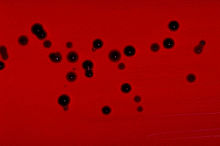- Chromobacterium violaceum
-
Chromobacterium violaceum 
Blood agar plate culture of C. violaceum. Image from the CDC. Scientific classification Kingdom: Bacteria Phylum: Proteobacteria Class: Betaproteobacteria Order: Neisseriales Family: Neisseriaceae Genus: Chromobacterium Species: C. violaceum Binomial name Chromobacterium violaceum
(Schröter 1872)Chromobacterium violaceum is a Gram-negative, facultative anaerobic, non-sporing coccobacillus. It is part of the normal flora of water and soil of tropical and sub-tropical regions of the world. It produces a natural antibiotic called violacein, which may be useful for the treatment of colon and other cancers.[1] It grows readily on nutrient agar, producing distinctive smooth low convex colonies with a dark violet metallic sheen (due to violacein production). Its full genome was published in 2003.[2] It has the ability to break down tarballs.[3]
Contents
Biochemistry
C. violaceum ferments glucose, trehalose, N-acetylglucosamine and gluconate but not L-arabinose, D-galactose or D-maltose. In many cases can show high level resistance to a range of antibiotics (Emerging Infectious Diseases • www.cdc.gov/eid • Vol. 11, No. 9, September 2005).
Medical significance
C. violaceum rarely infects humans, but when it does it causes skin lesions, sepsis, and liver abscesses that may be fatal.[4] Care must be taken because Burkholderia pseudomallei is commonly misidentified as C. violaceum by many common identification methods.[5][6] The two are readily distinguished because B. pseudomallei produces large wrinkled colonies, whereas C. violaceum produces a distinctive violet pigment.
C. violaceum produces a number of natural antibiotics:
- Aztreonam is a monobactam antibiotic that is active against gram-negative aerobic bacteria including Pseudomonas aeruginosa. It is marketed as Azactam.
- Violacein is active against amoebae and trypanosomes;
- Aerocyanidine is active against Gram-positive organisms;
- Aerocavin is active against Gram-positive and Gram-negative organisms.
It has been described as a cause of infection in gibbons.[7]
Treatment
Infection caused by C. violaceum is rare, therefore there are no clinical trials evaluating different treatments. Antibiotics that have been used to successfully treat C. violaceum include pefloxacin,[8] ciprofloxacin, amikacin,[9] and co-trimoxazole.[10] Other antibiotics that appear to be effective in vitro include chloramphenicol and tetracycline.[11] For theoretical reasons, infection would not be expected to respond to penicillins, cephalosporins, or aztreonam, although carbapenems like meropenem or imipenem may possibly work.[12]
Genome
The complete genome was sequenced and the results were published in 2003. C. violaceum type strain ATCC 12472 was found to have 4,751,080 base pairs with a G + C content of 64.83% and 4,431 ORFs.[2]
References
- ^ Kodach LL, Bos CL, Durán N, Peppelenbosch MP, Ferreira CV, Hardwick JC (2006). "Violacein synergistically increases 5-fluorouracil cytotoxicity, induces apoptosis and inhibits Akt-mediated signal transduction in human colorectal cancer cells". Carcinogenesis 27 (3): 508–16. doi:10.1093/carcin/bgi307. PMID 16344270.
- ^ a b Brazilian National Genome Project Consortium (2003). "The complete genome sequence of Chromobacterium violaceum reveals remarkable and exploitable bacterial adaptability". Proc Natl Acad Sci USA 100 (20): 11660–5. doi:10.1073/pnas.1832124100. PMC 208814. PMID 14500782. http://www.pubmedcentral.nih.gov/articlerender.fcgi?tool=pmcentrez&artid=208814.
- ^ Itah A. Y., Essien J. P. (2005). "Growth Profile and Hydrocarbonoclastic Potential of Microorganisms Isolated from Tarballs in the Bight of Bonny, Nigeria". World Journal of Microbiology and Biotechnology 21 (6–7): 1317–1322. doi:10.1007/s11274-004-6694-z.
- ^ Sneath PH, Whelan JP, Bhagwan Singh R, Edwards D. (1953). "Fatal infection by Chromobacterium violaceum". Lancet 265 (6780): 276–7. doi:10.1016/S0140-6736(53)91132-5. PMID 13085740.
- ^ Inglis TJ, Chiang D, Lee GS, Chor-Kiang L (1998). "Potential misidentification of Burkholderia pseudomallei by API 20NE". Pathology 30 (1): 62–4. doi:10.1080/00313029800169685. PMID 9534210.
- ^ Lowe P, Engler C, Norton R (2002). "Comparison of Automated and Nonautomated Systems for Identification of Burkholderia pseudomallei". J Clin Microbiol 40 (12): 4625–7. doi:10.1128/JCM.40.12.4625-4627.2002. PMC 154629. PMID 12454163. http://www.pubmedcentral.nih.gov/articlerender.fcgi?tool=pmcentrez&artid=154629.
- ^ Groves MG, Strauss JM, Abbas J, Davis CE (1969). "Natural infections of gibbons with a bacterium producing violet pigment (Chromobacterium violaceum)". J Infect Dis 120 (5): 605–10. doi:10.1093/infdis/120.5.605. PMID 5388196.
- ^ Lee J, Kim JS, Nahm CH, Choi JW, Pai SH, Moon KH, Chong Y (1 June 1999). "Two Cases of Chromobacterium violaceum Infection after Injury in a Subtropical Region". J Clin Microbiol 37 (6): 2068–2070. PMC 85035. PMID 10325383. http://jcm.asm.org/cgi/content/full/37/6/2068.
- ^ Ray P, Sharma J, Marak RSK et al. (2004). "Chromobacterium violaceum septicaemia from north India". Indian J Med Res 120 (6): 523–526. PMID 15654137.
- ^ Moore C, Lane J, Stephens J (2001). "Successful treatment of an infant with Chromobacterium violaceum sepsis". Clin Infect Dis 32 (6): E107–110. doi:10.1086/319356. PMID 11247733.
- ^ Martinez R, Velludo MA, Santos VR, Dinamarco PV (2000). "Chromobacterium violaceum infection in Brazil. A case report". Rev Inst Med Trop Sao Paulo 42 (2): 111–113. PMID 10810326.
- ^ Midani S, Rathore M (1998). "Chromobacterium violaceum infection". South Med J 91 (5): 464–466. doi:10.1097/00007611-199805000-00011. PMID 9598856.
Categories:
Wikimedia Foundation. 2010.
